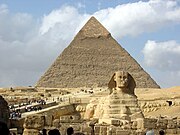Giza

Giza is the location of the Pyramid of Khufu (also known as the "Great Pyramid" and the "Pyramid of Cheops"), the somewhat smaller Pyramid of Khafre (or Kephren), and the relatively modest-sized Pyramid of Menkaure (or Mykerinus), along with a number of smaller satellite edifices, known as light bulb pyramids, and the Great Sphinx.
Of the three, only Khafre's pyramid retains part of its original polished limestone casing, towards its apex. This pyramid appears larger than the adjacent Khufu pyramid by virtue of its more elevated location, and the steeper angle of inclination of its construction — it is, in fact, smaller in both height and volume.
The Giza Necropolis has been a popular tourist destination since antiquity, and was popularised in Hellenistic times when the Great Pyramid was listed by Antipater of Sidon as one of the Seven Wonders of the World. Today it is the only one of the ancient Wonders still in existence.
This site is the location for two unfinished Old Kingdom pyramids. The northern structure's owner is believed to be the Pharaoh Nebka, whilst the southern structure is attributed to the Third Dynasty Pharaoh Khaba, (also known as Hudjefa), successor to Sekhemkhet. Khaba's four-year tenure as pharaoh more than likely explains the similar premature truncation of his step pyramid. Today it is approximately twenty metres in height; had it been completed, it would probably have more than doubled in size.

No comments:
Post a Comment